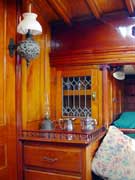
|
|
 |
|
|
Volume 13, Issue 40 ~ October 6 - 12, 2005
|
|||
 Bewitched BewitchedCapt. Paul Itzel Fell Under the Spell of an Ancient Sea Witch by Alice Snively This is not a Halloween story, but it is a story of Witchcraft, a 102-year-old sloop, oft called the witch by her owner, Capt. Paul Itzel. While boaters and would-be boaters from the region and beyond attend the Annapolis boat show to review the gleaming hulls of all manner of new vessels, the fully restored lady quietly shows off her sexy lines, varied woods, sparkling brass and bronze in her berth in Pasadena. She doesn’t play with young pretenders. The 60-foot Witchcraft is a true blue blood of yachts. Launched in May of 1903, she is an historic yacht, according to the Antique and Classic Boat Society, which accords that honor to boats built prior to 1918. It is generally believed that Witchcraft is the oldest yacht of her size still sailing the Bay. Designed by the late B.B. Crowninshield, she was built by the renowned Lawley boat yard in Boston, Massachusetts. She was built as an engineless yacht originally gaff rigged with main and mizzen masts. Over time through the hands of various owners, her rigging was changed to that of the more familiar Bermuda single-masted sloop, but she’s still a show-stopper when she’s out cruising. “People notice her everywhere she goes,” Itzel says. “Everything about her is so beautiful, so classic, you just about can’t miss her. You know she’s special.”  From Sea Hag to Good Witch From Sea Hag to Good WitchLife hasn’t always been so good for the lovely witch. When Itzel rescued her from oblivion, she “really looked like a witch of a boat,” he says. That was back in 1970, and for all of the 35 years since, the captain and his boat have seldom been apart. Pictures of her before her reclamation bear out his claims. Most people would have walked away from such a massive restoration challenge. Not Itzel, who was in his early 20s and full of dreams. “I knew from the time I was a teenager that I wanted to work on boats,” he says. After college, a couple of desk jobs and time in the Army, Itzel was looking to apprentice at a boat yard. He was job hunting when he found his witch. The elderly owner told him he could have her for $1,200 and move aboard right away. “I couldn’t afford my apartment in the city and restore the boat too, so I took the boat,” Itzel says. “I had no idea what I was getting into, but I had an apartment on the water.” He soon found an apprenticeship and could afford to begin restoration. As he uncovered more of his boat’s history, her design and construction, her luxury interior and seaworthiness, Itzel became even more bewitched. He determined to bring her back as close to her original configuration as possible. It would be a job, tackled with help from family and friends through the early years of the project. The boat had been stripped of much of her hardware and interior appointments. Even her wheel and binnacle had been poached. What wasn’t missing had been painted over, including the hardware. Rot was prolific. Money was always in short supply, but ingenuity was plentiful. After a miserable first winter aboard, with leaks everywhere, Itzel realized she would have to be hauled. But he couldn’t afford to put her in dry dock at a regular boat yard. Hurricane Agnes brought him a solution. In 1973 he and his brother George foraged wood and other materials dislocated by Agnes. On a farm near Pasadena, they built a shed that measured about 75 by 25 feet and stood 30 feet high. That ramshackle house of cards provided sheltered work space for Witchcraft for the next three years. Until it fell down; literally. “Hey, we foraged for it,” he says. “In fact it’s kind of surprising it stood as long as it did.” It would be many years before he could sail her. Over the years of restoration, life was lean. Nearly every penny he made went into the boat. He lived in a step van, lived with friends and lived in a teepee. From the 1970s to the early ’90s, when he couldn’t live aboard her, he lived nearby. Making boat deliveries, which paid well, was about the only thing that kept him any distance away from his ship. The work continued on and off as he had funds to apply to it. Friends and family helped not only by working alongside him but also by keeping his spirits up. “I could never, ever repay the debt I owe to these people,” he says, “but I think they are as proud of saving this piece of American maritime heritage as I am.” Million-Dollar Witch  The latest marine survey lists Witchcraft’s insured value at more than $1 million. The captain has no idea how much he’s actually spent because it was done over so long. “I have all the receipts stored at my dad’s house, but I don’t have time to add them up,” he says. Thirty-five years of part-time labor alone at today’s wages would be a fortune. The latest marine survey lists Witchcraft’s insured value at more than $1 million. The captain has no idea how much he’s actually spent because it was done over so long. “I have all the receipts stored at my dad’s house, but I don’t have time to add them up,” he says. Thirty-five years of part-time labor alone at today’s wages would be a fortune.Apart from labor, what makes this yacht so valuable? Age is part, but not all, of her value. “You can go to the boat show, and spend any amount of money. But those are production boats,” explains Iztel. “There is only one Witchcraft. There is not and never was another boat like her.” Only one, 102 years old, beautifully restored. Materials also raise her value. Nine different woods were used in her reconstruction, including white oak, mahogany, teak, white cedar, Sitka spruce, cherry, butternut, fir and iroka, each for a particular purpose. Her interior is primarily butternut, with cherry flooring. The cockpit and much of the exterior wood is mahogany, the deck hatch frames and covers teak, and the mast Sitka spruce. The other woods were used for frame, keel, planking and other hidden parts of her structure. Itzel searched far and wide for supplies of quality wood he could afford or bargain for. More than 2,000 board feet of white oak were needed, about 1,000 feet of mahogany, enough white cedar to plank the entire craft, teak for decking and other areas, plus varying quantities of the other woods. The butternut came from Connecticut; iroka is a hard wood from Asia. Some of the wood came from trees felled by Hurricane Andrew in Florida. Itzel refused to settle for inferior material or to take shortcuts in workmanship. All the learning and effort on his boat and others has earned him a reputation as a master shipwright, cabinetmaker and joiner. Some of her heavier hardware had to be specially cast because it was unique, and many smaller pieces had to be handcrafted. Itzel made detailed wood patterns for much of this hardware so it could be made by professionals. Every screw, hinge, winch, mast fitting, all the metal pieces that had to be replaced had to be made precisely to fit. The aspiring master learned the hard way that if he took something apart, he’d have to put it back together exactly the same way, because hardware pieces that looked identical in fact were not. Details from the wooden blocks of her rigging to the carved interior appointments are quiet testimony to the love, perseverance and drive for perfection lavished on her.  Casting Her Spell Casting Her SpellFor two decades, Witchcraft was a boat out of water. Not until 1992 was there a ceremonial launch, sans rigging. Two years later, she was rigged and under sail, but not for long. In 1996 she was hauled out for additional work. Finally in 1999, four years short of her centennial, she returned to the water at her new home in Pasadena, Itzel’s home territory, and only a few hundred yards from where he found her. Photographs of her interior cannot do justice to her beauty. Rich paneling, polished brass ports, leaded glass cabinet doors, hand-carved appointments — all invoke memories of the gold-plated days of yachting, circa 1880 to 1905, known now only through pictures and stories. Some of Itzel’s friends say he has remained a bachelor because he’s married to his witch. He says that’s only partly true. “I haven’t been able to afford a wife,” he says. After years of anonymity, Witchcraft and her captain gained recognition when her historic designation got her included in Operation Sail 2000. You may remember the sleek little sloop skimming along among the tall ships. Comments from people who’ve signed her visitors log range from “awesome” to “great brightwork” (clearly an entry from a serious sailor or boat worker), to “beautiful” and “wow, wow, wow!” The first time I saw her was at OpSail, and even from a distance her special beauty was striking. Up close and onboard, the impulse is to study every detail in silence. Many visitors have admitted that taking leave of her is a little sad. Since then, Itzel has continued to enjoy pleasure sailing on his beloved yacht, but with a new challenge.  Sailing into the Future Sailing into the FutureToday, tanned and muscled from his years of boat work, Itzel wears his blond, gray-tinged hair in the long braid he’s kept since the days when he rescued Witchcraft. The style is right, for he says he’s still a hippie dreamer. But neither she nor he has drunk at the fountain of eternal youth. “I’ll be 60 years old in two years,” he says, “and I have to think about my future as well as hers.” As Itzel sees it, he as two options: sell her or get sponsors. “I have given most of my adult life to this boat, but it’s costly to maintain her,” he says. “I can’t do that forever.” Recently he was approached by a serious prospective buyer, and their dialogue continues. If he should sell her outright, Itzel says he will buy a newer, smaller boat that won’t need the critical care required by the witch. The option of sponsorship is in some ways more appealing. “Major boat races, marine events, classic and antique boat shows, all have boats with hulls or sails covered with sponsor names,” he says. Sponsorship would also allow him to remain faithful to his mistress. With sponsors, he could afford to go forward with restoring the mizzen, gaff rigging and sails. His vision is to have a crew, in 1900s period dress, and travel the East Coast from event to event. “There are enough of these to keep her on the go from April to October,” he says, “and there are many sponsored boats out there, so clearly it pays off for them.” How to attract sponsors, however, Itzel says he knows nothing about, and he can’t afford to hire a marketing firm. Knowledgeable advice would be welcome. Itzel’s friends will tell you they don’t think he’ll ever be happy far from his witch. They say the spell she cast on him is unbreakable. He says “No comment.”
|
|||
|
|
|||
|
© COPYRIGHT 2004 by New Bay Enterprises, Inc. All rights reserved. |
 About the Author
About the Author